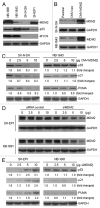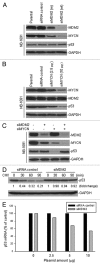Crosstalk between MYCN and MDM2-p53 signal pathways regulates tumor cell growth and apoptosis in neuroblastoma
- PMID: 21862876
- PMCID: PMC3218600
- DOI: 10.4161/cc.10.17.17118
Crosstalk between MYCN and MDM2-p53 signal pathways regulates tumor cell growth and apoptosis in neuroblastoma
Abstract
Previous studies show that the MYCN and MDM2-p53 signal pathways are mutually regulated: MYCN stimulates MDM2 and p53 transcription, whereas MDM2 stabilizes MYCN mRNA and induces its translation. Herein, we report that the interaction between MDM2 and MYCN plays a critical role in MYCN-amplified neuroblastoma tumor cell growth and survival. Distinct from the known role that MDM2 has in regulating tumor promotion in non-MYCN-amplified neuroblastoma, in which MDM2 inhibits p53, we found that MDM2 stimulated tumor growth in MYCN-amplified neuroblastoma in a p53-independent manner. In MYCN-amplified neuroblastoma cells, enforced expression of MDM2 further enhanced MYCN expression, yet no p53 inhibition was observed by MDM2 due to upregulation of MYCN that stimulated p53 transcription. Similarly, p53 expression remained unchanged in MDM2-silenced MYCN-amplified neuroblastoma cells because MDM2 inhibition resulted in a downregulation of MYCN that decreased p53 transcription, although the MDM2-mediated degradation of p53 was reduced. Also, we found that the enforced overexpression of MDM2, or conversely, the inhibition of overexpressed endogenous MDM2, led to either a remarkable increase or decrease in tumor growth, respectively, in MYCN-amplified neuroblastoma (even though no p53 function was involved). These results suggest that p53 that is reciprocally regulated by MDM2 and MYCN is dispensable for suppression of MYCN-amplified neuroblastoma, and that the direct interaction between MDM2 and MYCN may contribute significantly to MYCN-amplified neuroblastoma growth and disease progression.
© 2011 Landes Bioscience
Figures





Similar articles
-
MYCN sensitizes neuroblastoma to the MDM2-p53 antagonists Nutlin-3 and MI-63.Oncogene. 2012 Feb 9;31(6):752-63. doi: 10.1038/onc.2011.270. Epub 2011 Jul 4. Oncogene. 2012. PMID: 21725357 Free PMC article.
-
Mdm2 deficiency suppresses MYCN-Driven neuroblastoma tumorigenesis in vivo.Neoplasia. 2009 Aug;11(8):753-62. doi: 10.1593/neo.09466. Neoplasia. 2009. PMID: 19649205 Free PMC article.
-
MYCN-directed centrosome amplification requires MDM2-mediated suppression of p53 activity in neuroblastoma cells.Cancer Res. 2007 Mar 15;67(6):2448-55. doi: 10.1158/0008-5472.CAN-06-1661. Cancer Res. 2007. PMID: 17363562
-
The interaction between FAK, MYCN, p53 and Mdm2 in neuroblastoma.Anticancer Agents Med Chem. 2014 Jan;14(1):46-51. doi: 10.2174/18715206113136660331. Anticancer Agents Med Chem. 2014. PMID: 24041229 Review.
-
MDM2 as MYCN transcriptional target: implications for neuroblastoma pathogenesis.Cancer Lett. 2005 Oct 18;228(1-2):21-7. doi: 10.1016/j.canlet.2005.01.050. Cancer Lett. 2005. PMID: 15927364 Review.
Cited by
-
Noscapine induced apoptosis via downregulation of survivin in human neuroblastoma cells having wild type or null p53.PLoS One. 2012;7(7):e40076. doi: 10.1371/journal.pone.0040076. Epub 2012 Jul 26. PLoS One. 2012. PMID: 22848370 Free PMC article.
-
A Novel Therapeutic Mechanism of Imipridones ONC201/ONC206 in MYCN-Amplified Neuroblastoma Cells via Differential Expression of Tumorigenic Proteins.Front Pediatr. 2021 Aug 4;9:693145. doi: 10.3389/fped.2021.693145. eCollection 2021. Front Pediatr. 2021. PMID: 34422720 Free PMC article.
-
Didymin: an orally active citrus flavonoid for targeting neuroblastoma.Oncotarget. 2017 Apr 25;8(17):29428-29441. doi: 10.18632/oncotarget.15204. Oncotarget. 2017. PMID: 28187004 Free PMC article. Review.
-
A critical evaluation of PI3K inhibition in Glioblastoma and Neuroblastoma therapy.Mol Cell Ther. 2014 Oct 27;2:32. doi: 10.1186/2052-8426-2-32. eCollection 2014. Mol Cell Ther. 2014. PMID: 26056598 Free PMC article. Review.
-
MYCN-mediated regulation of the HES1 promoter enhances the chemoresistance of small-cell lung cancer by modulating apoptosis.Am J Cancer Res. 2019 Sep 1;9(9):1938-1956. eCollection 2019. Am J Cancer Res. 2019. PMID: 31598396 Free PMC article.
References
-
- Maris JM, Matthay KK. Molecular biology of neuroblastoma. J Clin Oncol. 1999;17:2264–2279. - PubMed
Publication types
MeSH terms
Substances
Grants and funding
LinkOut - more resources
Full Text Sources
Medical
Research Materials
Miscellaneous
